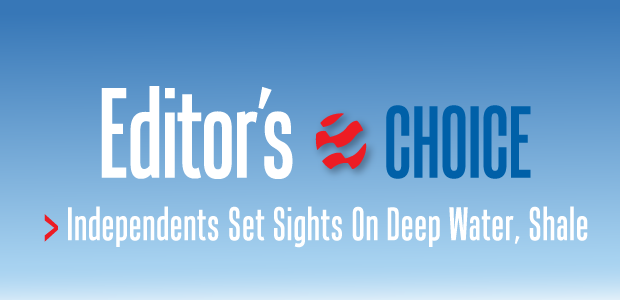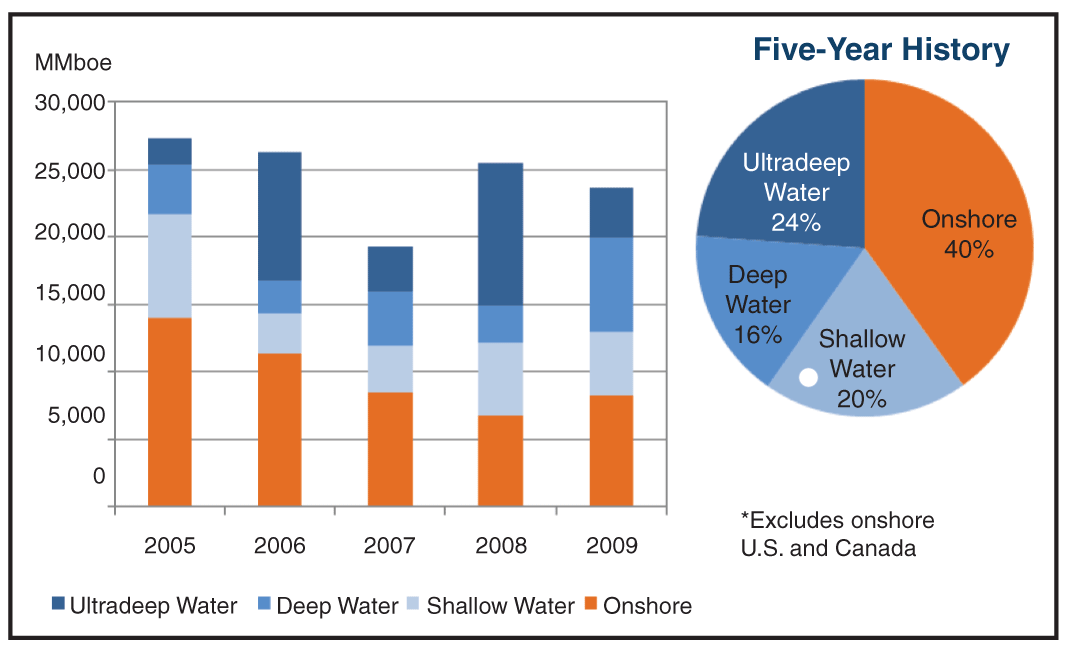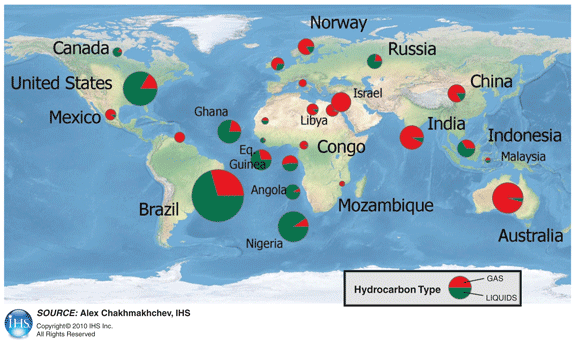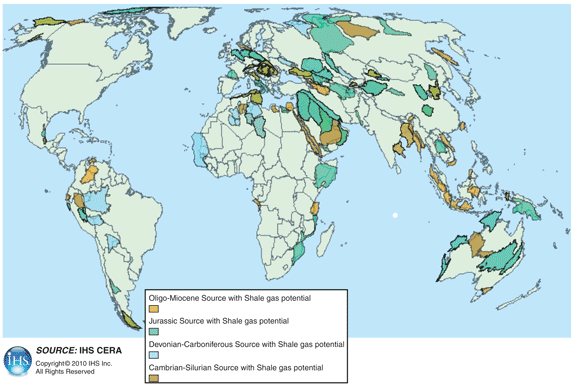
International Opportunities
Independents Setting Sights On International Opportunities In Deep Water, Shales And EOR
By Philip H. “Pete” Stark, Bob Fryklund, Steve DeVito and Alex Chakhmakhchev
ENGLEWOOD, CO.–The United States has led the way in shale, deepwater and enhanced oil recovery operations. These three very different–and technologically demanding–environments have added billions of barrels of oil and trillions of cubic feet of natural gas reserves, reframing the long-term North American energy supply picture.
As a group, independent companies have been the dominant players in all three of these areas. It was independents that revolutionized the business by commercializing oil and gas shales, drilled the vast majority of deep- and ultradeepwater discoveries in the Gulf of Mexico over the past decade, and transitioned onshore fields from primary to secondary and then tertiary recovery (and now are proving up the concept of “residual oil zones” below the perceived oil/water contact in carbonate reservoirs).
Mirroring trends in the United States, deepwater and EOR technologies are finding widespread application around the globe, and shales are emerging as a key component for international activity. Not surprisingly, U.S. independents as well as service and supply companies are in the thick of the action.
Crude oil is still king in international exploration and production. The recession of 2008-09 again demonstrated that oil is more resilient than natural gas on the global market. When an economic down cycle occurs, oil historically bounces back faster and stronger than gas. At the end of the first quarter of 2009, West Texas Intermediate was trading under $50 a barrel. By the end of the first quarter of this year, WTI prices had more than doubled, rebounding to above $100 a barrel for the first time since September 2008. Geopolitical issues obviously factor heavily into crude oil prices, but the price recovery appears to be on solid footing with improving fundamentals in the global economy.
Even in the United States, where natural gas accounted for almost 90 percent of all drilling activity only a few years ago, corporate portfolios are demonstrating a strong preference for liquid reserves. In fact, for the first time since the mid-1990s, U.S. operators completed more oil wells than gas wells in 2010. Much of the activity, of course, is focused on horizontal drilling in oil and liquids-rich shales–from the Bakken to the Eagle Ford, Marcellus, Niobrara and Barnett.
That is not to suggest, however, that natural gas has fallen out of favor. To the contrary, the success of shale gas development in North America has illustrated the vast potential of unconventional reservoirs, and is giving independents with expertise in developing these resources new opportunities to establish long-term ventures in emerging shale plays in gas-hungry markets from continental Europe to South America.
Offshore Opportunities
Offshore, the restricted activity in the deepwater Gulf of Mexico is beginning to ease with the first approved drilling permits since the moratorium was put in place nearly a year ago. However, the single biggest impact of last April’s tragedy in the Gulf will be the U.S. government’s regulatory response to it. The operating environment in the Gulf is undergoing significant change, and countries around the world can be expected to follow the Obama administration’s lead to varying degrees in implementing new deepwater standards and practices.
These changes likely will lead to consolidation in the Gulf and have the effect of increasing project costs and adding scheduling delays to achieving first oil. Consequently, smaller operators are assessing international offshore operations, and looking to go where governments are more transparent and friendlier to exploration and production.
The good news is that there are good deepwater opportunities around the world. Oil-prone blocks off both the eastern and western coasts of Africa appear to offer particularly good investment opportunities for independents seeking to negotiate favorable licensing terms on concessions with geologic and operating corollaries to the deepwater Gulf.
Data on international discoveries made since 2005 illustrate how important deep- and ultradeepwater acreage is becoming to world energy supply (Figure 1). From 2005 to 2009, new reserves discovered in more than 400 meters of water equaled the total of all new onshore reserves discovered outside of North America. Almost one-quarter of the total new reserves added during these five years were in ultradeep waters (greater than 1,500 meters). And when shallow-water fields in less than 400 meter depths are added, the offshore accounted for 60 percent of all oil and gas discoveries.
During 2010, ultradeepwater discoveries were even more prominent, accounting for almost half of the 28.3 billion barrels of oil equivalent reserves discovered outside of onshore North America.
Looking at the distribution of deepwater reserve additions, the world leader by far over the past five years was Brazil, followed by the U.S. Gulf, Australia, India, Angola, Ghana, Nigeria and Israel. The Atlantic Coast margin–spanning from Nigeria, Angola, Equatorial Guinea, Ghana, the deepwater Gulf of Mexico and Brazil–tends to be more liquids prone than gas prone. On the other hand, large reserves discovered offshore Australia, India and Israel are predominately gas.
The list of the top 20 operators of offshore discoveries since 2005 consists of five national oil companies, seven majors and eight independents. The NOCs and majors have accounted for the largest volumes of reserves discovered, led by Petrobras, BG Group, Shell, BP, ExxonMobil, Chevron and Angola’s state-owned Sonangol. However, independents certainly are playing an active role in the international offshore and making significant discoveries. Anadarko comes in at number eight in terms of the volume of reserves discovered since 2005, with Noble Energy, Husky, Tullow and Marathon also ranking in the top 20. Deepwater discoveries propelled independents OGX Petroleo e Gas, Noble Energy and Rockhopper Exploration into the top 10 companies in terms of reserves discovered in 2010.
Deepwater Discoveries
Independent-operated deepwater discoveries include:
- Anadarko Petroleum Corporation’s Windjammer in the frontier Rovuma Basin offshore Mozambique;
- The Jubilee, Tweneboa and Tano discoveries offshore Ghana, in which Anadarko, Houston-based Sabre Oil & Gas, and Dallas-Based Kosmos Energy are partners with U.K. independent Tullow Oil;
- The Noble Energy Leviathan and Tamar gas discoveries in the Mediterranean Sea offshore Israel (Leviathan was one of the three largest discoveries made in 2010, with an estimated 16 Tcfe in reserves); and
- Vanco Energy’s discovery in the Cape Three Points deepwater block in the Gulf of Guinea offshore Ghana.
Foreign-based international independents also are making headlines in deep water. An example is OGX Petroleo e Gas, led by Brazilian entrepreneur Eike Batista, which made two of the largest oil discoveries in the world last year in the Campos Basin offshore Brazil (each discovery is estimated to contain 500 million boe).
Brazil is the world’s offshore hot spot, and it seems that a new company is being formed almost every month in Rio de Janeiro. Although the Brazilian industry is dominated by state-owned Petrobras, Anadarko, Gran Tierra Energy and other U.S. and Canadian independents, plus Brazilian independents such as Petra Energia, Queirz Galvao and HRT, are working both on- and offshore Brazil.
Looking at the map of deepwater discoveries (Figure 2), the most prospective international areas for independents seem to be offshore Africa, the equatorial margin of northern Latin America, Australia, and now the eastern Mediterranean. Secondarily are regional focal points such as the North Sea, where several U.S. independents have active projects, Caribbean waters such as offshore Trinidad and Tobago, where independents are involved in gas developments for export as LNG, and offshore South Africa, where Pioneer Natural Resources and others have had success.
In addition, Southeast Asia is always a sleeper region. While elephant-sized discoveries are a rarity, the region long has been fertile offshore ground for independents, with a history of good discoveries and reasonable fiscal terms. Malaysia, Indonesia and Vietnam all have underexplored deepwater basins that give independents exposure to significant reserves potential. Examples of such opportunities include Eni/Anadarko’s 25 million-boe Tulip discovery in the Upper Miocene of the Greater Tarakan Basin in Indonesia and Newfield’s small, but interesting gas discoveries in Oligocene-Miocene clastics in the North Luconia province offshore Malaysia.
Murphy Oil Corporation’s string of oil and gas discoveries offshore Malaysia, including the Kikeh and Sarawak projects, established the economic potential for this region. Offshore fiscal terms and licensing opportunities might best be described as a mixed bag. Some host governments have restructured their policies to encourage investment by independents in competitive license rounds. However, others are using offshore acreage as “negotiation bait” with NOCs to finance internal infrastructure projects. The focus on infrastructure rather than oil and gas exploration as the primary driver for outside investment is a new trend that is beginning to reduce some of the offshore areas that might otherwise be of interest to independents.
‘Shale Gale’
Onshore, the “shale gale” that started in North America is quickly moving around the world as companies search for new development opportunities. Europe is at the head of the international shale play list because of market-driven opportunities resulting from the continent’s reliance on Russian gas imports and search for more diversification of supply. Although ConocoPhillips, Chevron, Shell, Total and ExxonMobil have active projects, independents are leading the rush into European shales just as they did in the United States and Canada.
A number of basins appear to have shale formations with considerable amounts of gas in place. Although no major developments have been announced to date, shales are being tested across Europe. There is a lot of interest in Hungary, Turkey, the Ukraine and the Paris Basin, although the industry is encountering some political and environmental resistance in the Paris Basin.
Poland, in particular, has very high potential in thick, laterally extensive Silurian shales with favorable organic and silica characteristics. A stable political environment and reasonable fiscal terms make Poland all the more attractive for independents interested in international shale resource plays. Early movers include Marathon, Talisman Energy, Lane Energy, Schuepbach Energy and Canadian independent LNG Energy.
A number of geologic and scientific uncertainties have yet to be worked through, but the biggest challenges to European shales may prove to be above ground. The scale of shale development is going to be much harder to replicate than it was in North America. It remains to be seen whether Europeans are going to be amenable to the large scale of operations or the rapid drilling and development pace that shale play economics require.
Another factor is that outside of Poland and the Paris Basin, European shales do not appear to be as liquids-rich as they are in North America. Liquids recovery has been critical to operating economics in the prevailing commodity price climate in which oil is priced at a premium to natural gas on a Btu equivalent basis.
A more immediate concern is a lack of services and infrastructure. One reason shales in the United States have been so successful is that the services and infrastructure are in place to support drilling and development. The lack of services and equipment capable of supporting horizontal drilling and hydraulic fracturing may mean that instead of costing $4 million-$5 million in a U.S. basin, drilling and completion costs to test a shale formation in Europe could run $8 million-$10 million per horizontal well, or perhaps even $15 million-$20 million in more remote locations.
Scanning The Globe
Despite rather daunting issues associated with international oil and gas shale development, there are lots of smaller companies run by very smart people who know the technology and know what characteristics to look for in a formation. They are scanning the globe for the right rocks and the right market opportunities, and they will no doubt figure out ways to apply technology to make some of the plays work, just as was the case in North America.
Global shale exploration is still at a very early stage, but in addition to Europe, independents are testing shales onshore South Africa, Australia, China, Latin America, South Africa and North Africa. Figure 3 illustrates the widespread distribution of gas-prone source rocks outside of North America by geological age.
The size of the potential shale prize varies by region, but estimates tend to be large. For example, the Algerian government estimates 1,000 Tcf of domestic shale gas resource potential. Algeria has the same Silurian-aged rocks that are being explored in Europe, and they extend across North Africa into the Arabian platform in the Middle East.
The economic metrics for development vary by region, with “pockets” of demand for shale gas. In some cases, the economic viability of shale plays is all about the characteristics of the rocks. In other cases, economics may be negatively impacted by a lack of local markets or infrastructure. In China and India, market demand is strong and both countries appear to have prospective shale geology, but they can be tough places for independents to do business (although, India in particular, has been hospitable in the past to smaller companies interested in tight sands and coalbed methane projects) and shale is generally a long way from markets and existing infrastructure.
In areas such as the Middle East and Australia, market opportunities are far less apparent and the sheer amount of conventional reserves makes it difficult for shales to become the low-cost supply source they are in North America. In Australia, for instance, shale gas potential is considerable. However, the question is what kind of market exists for 30 Tcf-50 Tcf of shale gas when Australia already has 70 Tcf of new volume coming on line from the Northwestern Shelf and Queensland?
In Indonesia, where coalbed methane has been the focus of unconventional resource development, strategies are driven by the need to “fill the pipeline.” The local liquefied natural gas plant is running tight on conventional supplies and the pipeline operator is obligated by take-or-pay contracts to maintain a specified delivery volume to the LNG plant.
Latin America
Moving to South America, early shale gas development work has concentrated on the Vaca Muerta and Los Molles shales in the Neuquen Basin in Argentina. Tests results from initial drilling by Repsol YPF have been encouraging, and independents with active holdings in Neuquen Basin shales include Apache, Tulsa-based Apco Oil & Gas International, and Metro Gas. Spurring Argentine shale development is the “Gas Plus” plan, which was approved by the government in 2008 to offer improved fiscal terms to operators of new projects.
To the north in neighboring Uruguay, Dallas-based Schuepbach Energy has signed a two-year contract with NOC Ancap to explore for shale gas in a 10,000 square-kilometer area in the northern part of Uruguay, near the borders with Brazil and Argentina.
Looking at conventional oil and gas, Colombia and Peru continue to solicit interest from independents. Both governments have undertaken efforts to restructure fiscal terms and licensing rounds to attract smaller and mid-sized independents, and it appears to be paying off.
Calgary-headquartered Gran Tierra Energy is an example of a smaller independent that is achieving notable success in Latin America. In fact, it ranks among the fastest growing exploration and production companies in the region. With sizeable concession acreage in Colombia, Peru, Brazil and Argentina, Gran Tierra grew its net daily oil production from 700 barrels in 2006 to about 20,000 barrels last year in Colombia alone.
Even in Mexico, which historically has been closed to outside investment, Pemex is offering incentive-based contracts for mature fields as outlined in a 2008 reform law that permits a production bonus to the operator for each barrel of oil production above predetermined output targets. Pemex is planning three tenders in 2011 under the new contracts for mature onshore fields, and future contracts reportedly will include deepwater Gulf fields, perhaps beginning as early as 2012. In addition, opportunities to extend the Eagle Ford Shale play into Mexico are attracting attention from independents.
Field Growth
International activity took a pause during the economic downturn largely because the capital markets dried up, especially for pure exploration companies. Over the past 12 months, however, global activity among medium- and small-sized independents has experienced a resurgence. In some regions, in fact, the growth of independents is outpacing the NOCs.
Because they are willing to take on the risks inherent in exploration and development, independents will continue to target deep water and shales as long as the resource potential is in place and the terms make it possible. Going forward, however, a significant percentage of oil reserve additions can be anticipated in existing fields around the world.
From 2004-06, the combination of new liquids discoveries and liquids reserves added from growth within existing fields was less than 23 billion barrels annually, failing to keep pace with worldwide liquids consumption (which averaged 30 billion barrels a year between 2004 and 2010). But reserves from discoveries increased from 12 billion barrels in 2007 to 19 billion in 2009, and even more noteworthy, new reserves from field growth jumped from 27 billion barrels in 2007 to 44 billion barrels in 2009. IHS CERA found that 75 percent of the mature fields are located onshore and that national oil companies operate 70 percent of the mature field oil productive capacity.
The marked increase in field growth reflects that the re-engineering and enhanced recovery work initiated over the past decade in mature giant fields around the world is finally contributing to increased oil output. It took time for these redevelopment and waterflood projects to yield production responses, but it is clear that the investment in EOR in established oil fields is now generating measurable returns.
Most of the large 2009 increase in reserve additions related to growth in mature fields was credited to giant fields such as West Qurna and Zubair in Iraq, where redevelopment projects have commenced, and Ghawar in Saudi Arabia. There also are important mature fields across a wide range of countries and business environments. Independents could find rewarding opportunities in countries such as Indonesia, Oman, Argentina, Egypt, Malaysia and Colombia.
At the same time these EOR projects were being implemented around the world, U.S. operators were proving up shale reserves that represented the equivalent of discovering a supergiant field, which North America has not seen in decades. The synergies between these two trends could have some dramatic results in the years ahead, because what the industry has learned in domestic oil and gas shales is applicable to field redevelopment and EOR strategies in conventional reservoirs overseas.
Horizontal drilling and multistage fracturing have changed the game in both liquids and gas in the United States, and they also could prove to be global game changers. Although probably not to the same magnitude as in North America, introducing these technologies to existing fields will have significant regional impacts and help slow production and decline rates.
Another lesson learned in North American shales is that unconventional reservoirs can be found in basins where oil and gas has been produced for decades. There are numerous hydrocarbon-bearing rocks around the world that have not been developed because they failed to meet the conventional definitions of a reservoir. At a minimum, oil and gas operators are not going to give up on aging conventional fields before assessing their unconventional resource potential or the possible economic impact of applying the technologies that have put shale plays on the map.

PHILLIP H. “PETE" STARK is vice president, industry relations, at IHS CERA in Englewood, Co. In 1979, he left a position as geological computing coordinator at Mobil to join Petroleum Information Corp., now part of IHS, and has served in senior management positions in technical services, technical marketing and international operations. Stark serves on the board of the Public Petroleum Data Model Association, and was a lecturer on geologic computer applications for the AAPG’s continuing education program. He has also served as chairman of the Alumni Advisory Board for the University of Wisconsin’s geology and geophysics department. Stark holds a B.S. in geology from the University of Oklahoma, and an M.S. and a Ph.D. in geology from the University of Wisconsin.

BOB FRYKLUND is vice president of IHS CERA in Rio de Janeiro. He joined the company in July 2006 after serving as Libya president and Brazil country manager for ConocoPhillips. With more than 30 years of both international and domestic industry experience, Fryklund also has held senior leadership positions with British Borneo, Union Texas and Amerada Hess. He focuses on strategic solutions for the upstream arena and advises national oil companies, independent, majors and investors. He serves on several boards and committees, including the Independent Petroleum Association of America and the American Association of Petroleum Geologists. Fryklund holds a bachelor’s from Hamilton College and an advanced certificate in management. He also has completed advanced studies in business and geology from the University of Houston and the University of Tulsa, respectively.

STEVE DEVITO is senior director for regional teams for IHS Inc. Based in the company’s Houston office, he covers the Latin America and Frontier North America regions, and is responsible for overseeing Critical Information Development scouting and reports. With experience on six continents and more than 45 basins worldwide, DeVito has held domestic and international positions with Mobil, Enserch, Esso, Union Texas, Texas American Resources and IHS. He previously held management and executive-level positions and overseas assignments in London, Jakarta, Caracas, and Kuala Lumpur. DeVito holds a B.S. in geology from Binghamton University and an M.S. in geology from Wright State University.

ALEX CHAKHMAKHCHEV leads the exploration and production data advisory team in the IHS global customer care organization. He has 20 years of experience in the international petroleum business in research, exploration and consulting, including working with governmental research institutions as well as Russian and Japanese oil companies. In his current role, Chakhmakhchev analyzes IHS data and critical information to share insights on global industry trends with IHS clients. He holds an M.S. in geology from Moscow State University and a Ph.D. in geochemistry from the Information System for Geology Research Institute in Moscow.
For other great articles about exploration, drilling, completions and production, subscribe to The American Oil & Gas Reporter and bookmark www.aogr.com.


















